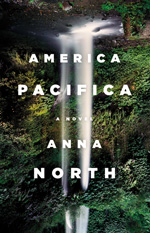

Reagan Arthur Books, hardcover, 9780316105125
Anna North's young adult novel, America Pacifica, is a grungy, thrill-a-minute frappe of familiar dystopian elements—skuzzy landscape, crazy tyrants, social and environmental exploitation—garnished with characters David Lynch might have abandoned on a back lot in the early '90s—a transsexual, circus folk, tattooed whores, and a one-armed man. The problem is that this book looks and tastes like most dystopian novels, but it lacks a good think kickback, which is the reason readers are willing to gag these books down.
The novel's main character, 19-year-old Darcy, is on a quest to find her mother, who has failed to come home from work one evening. As she searches the island—the last habitable place on an earth frozen in the clutches of a new ice age—Darcy becomes reluctantly embroiled in a plot to overthrow the island's dictator, whose minions live in nice gated communities supported by the hard-scrabble efforts of the working class. Think Sukarno, Marcos, Papa Doc.
Instead of real character and plot development, North relies on grotesques and danger. However, she does have a knack for setting, which becomes increasingly grotty as Darcy uncovers the political corruption on the island. For instance, the down-and-out apartment where Darcy and her mother live is made of Seaboard, a kelp product that "smelled like the dirty ocean after a long rain, and if you scratched it, it flaked away under your fingernails." The island is powered by a toxic solvent that has polluted the waters around the island (and also serves as a substance the more hopeless islanders can huff on the cheap):
There's also a convent of nuns who take a vow of silence and talk only through their parrots; a swanky white apartment whose only spot of color is a succulent rib roast; a ratty circus where Darcy is forced to do an Eskimo dance with a bear in white paint during which she falls and breaks her leg. While it may work for teenagers, the broken leg strikes an older reader as a somewhat ham-handed symbol of Darcy's coming of age:
America Pacifica strives for a big finish that doesn't quite work. Piecing together a half-baked notion that there might still be people on the ice-bound continent of North America, Darcy plans to steal a ship to go there and bring back help. North attempts the same kind of ambiguous ending Lois Lowry used in The Giver and Cormac McCarthy used in The Road, but anybody who remembers the third-grade geography unit about the Peary expedition would find it difficult to see much ambiguity in Darcy's fate as she approaches the icy waters off California.
Teenagers will doubtless like America Pacifica's squalor, and there are some pretty raw scenes
that will make them go, "Whoaaa!" Sadly, I suspect that the lesson (such as it is) that some problems
can't be solved by running away to be a hero, will be overlooked.
